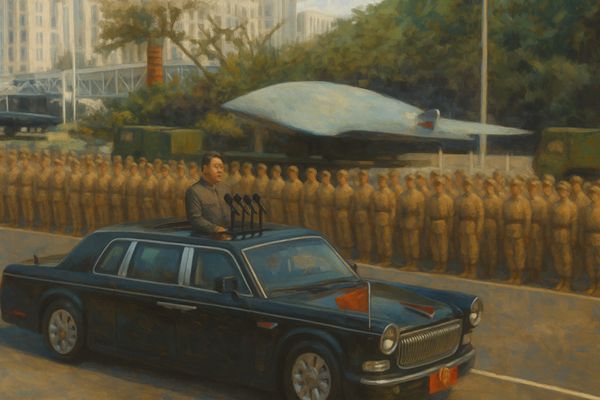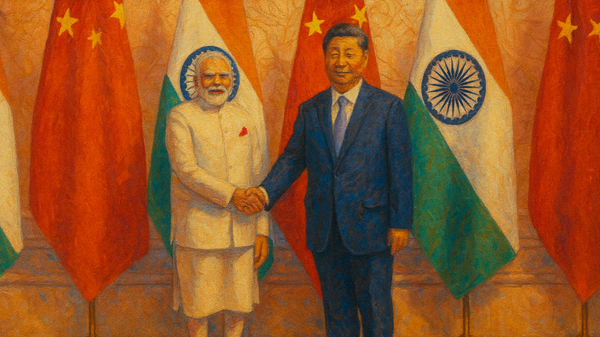Charting a New Course: The Future of US Military Strategy

The U.S. is pivoting from counter-terrorism to great power competition, focusing on China and Russia with a renewed emphasis on conventional deterrence, logistics, and forward-deployed forces.
Future strategy depends on integrated deterrence and rapid tech adoption, requiring reforms in procurement, investment in AI and cyber, and a cultural shift across the defense ecosystem.
Alliances are vital force multipliers, enabling strategic reach, interoperability, and resilience against economic and military coercion in both the Indo-Pacific and Europe.
The global security landscape is undergoing a profound transformation, demanding a fundamental recalibration of US military strategy. From the rise of peer competitors to the proliferation of disruptive technologies, the foundational assumptions of post-Cold War defense are being challenged. This analysis, drawing insights from a recent expert discussion, delves into the core tenets of this evolving strategy. It explores the shift towards integrated deterrence, the imperative of technological superiority, the indispensable role of alliances, and the internal adaptations required to secure American interests in an increasingly complex world.
The Evolving Global Chessboard: Drivers of Strategic Change
The primary geopolitical challenges and technological advancements reshaping the global security landscape necessitate a fundamental re-evaluation of US defense posture. The foundational shift in US military strategy is a decisive pivot away from counter-terrorism and towards great power competition, primarily with China and Russia. This marks a return to a more traditional, state-centric security paradigm, moving away from the asymmetric conflicts that dominated the past two decades. This strategic reorientation is not merely an additive process; it necessitates a significant reallocation of defense resources. Counter-terrorism operations typically relied on specialized units, localized intelligence, and irregular warfare tactics. In contrast, great power competition demands high-end conventional capabilities, advanced technological superiority, and large-scale logistical support. This implies the need for strategic divestment from capabilities optimized for counter-terrorism, which can be politically and institutionally challenging. The US military must become adept at strategic triage, making difficult choices about what to retain, what to shed, and where to accelerate investment, potentially leading to temporary capability gaps or reduced readiness in lower-priority areas during this transition.
While the strategic emphasis is on great power competition, future conflicts are unlikely to be purely conventional. Great powers frequently employ hybrid tactics, including cyber warfare, disinformation campaigns, economic coercion, and proxy conflicts, often operating below the threshold of armed conflict. Therefore, the US military cannot entirely abandon its expertise in irregular warfare or stability operations. The future of US military strategy is not a clean switch but rather an integration of high-end great power competition capabilities with persistent, albeit perhaps less emphasized, capabilities for hybrid threats. This creates a complex challenge of maintaining readiness across a broader and more ambiguous spectrum of conflict.
To illustrate these shifts, consider the following comparison:
| Category | Legacy Focus (e.g., Post-9/11 Era) | Future Focus (as per expert discussion) |
|---|---|---|
| Strategic Focus | Counter-terrorism/Insurgency | Great Power Competition |
| Primary Adversaries | Non-state Actors | China/Russia |
| Key Capabilities | COIN/SOF | High-end Conventional/Emerging Tech |
| Force Structure | Centralized/Expeditionary | Distributed/Resilient |
| Alliances Role | Burden-Sharing | Force Multiplier/Interoperability |
| Technological Imperative | Incremental Tech Upgrades | Rapid Innovation/AI/Cyber/Space |
China's rapid economic and military growth, coupled with its global ambitions, positions it as the primary pacing challenge for the US, particularly in the Indo-Pacific region. The strategic focus is on naval power, long-range precision fires, and countering China's growing Anti-Access/Area Denial (A2/AD) capabilities. The vastness of the Indo-Pacific region presents immense logistical challenges for projecting and sustaining US military power, especially when competing with China's increasingly sophisticated A2/AD capabilities. Unlike European operations with established NATO infrastructure, operating across the Pacific demands an unprecedented focus on resilient supply chains, distributed operations, and forward basing. This means that future US strategy must prioritize not just combat power but also the ability to sustain that power over vast distances and under contested conditions, necessitating significant investments in sealift, airlift, and pre-positioned stocks. This also underscores the crucial role of allies in providing access and basing. Furthermore, the deep economic interdependence between the US and China, while theoretically a deterrent to direct conflict, also creates significant vulnerabilities. A military strategy focused on competition with China must meticulously consider the potential economic fallout of any confrontation or even heightened tensions. This implies that military strategy cannot be developed in isolation; it must be tightly integrated with economic statecraft and diplomatic efforts to manage escalation and minimize economic disruption. A truly "whole-of-government" approach, where economic tools are as important as military ones, is essential for strategic success.
Russia's ongoing aggression in Ukraine, its nuclear arsenal, and destabilizing actions continue to make it an acute threat, particularly in Europe. This has led to a reinforcement of NATO's eastern flank and a renewed focus on collective defense and readiness. The simultaneous imperative to address China as the "pacing challenge" and Russia as the "acute threat" creates a significant strategic dilemma for the US. Resources—budgetary, personnel, and equipment—are finite. Prioritizing one theater or adversary could potentially leave vulnerabilities in another. The US must develop a strategy that allows for effective deterrence and, if necessary, conflict prosecution in both theaters, potentially requiring different force compositions, deployment models, and a nuanced reliance on allies for specific roles in each region. This highlights the need for exceptional strategic agility and rapid redeployment capabilities. Russia's actions in Ukraine have starkly demonstrated that large-scale conventional warfare remains a distinct possibility in Europe, challenging earlier assumptions about "hybrid warfare" being the primary form of conflict. This re-emphasizes the need for robust conventional deterrence, including ground forces, air power, and integrated air and missile defense, within NATO. While technological advancements are crucial, the fundamentals of conventional military power and readiness remain paramount. This will likely require increased defense spending from European allies and a re-evaluation of NATO's force posture on the continent to ensure credible deterrence.
Adapting to Tomorrow's Threats: Strategic Imperatives and Priorities
The evolving strategic landscape demands necessary doctrinal shifts, investment areas, and operational concepts for the US military.
A cornerstone of the future strategy is integrated deterrence, which seeks to deter aggression across all domains (land, sea, air, space, cyber) and across the spectrum of conflict. This approach leverages all instruments of national power—military, economic, diplomatic, and informational—to present a unified front. While "integrated deterrence" is conceptually powerful, its practical implementation is incredibly complex. It demands unprecedented levels of coordination and synchronization not only between military branches but also across diverse government agencies (e.g., Department of Defense, State Department, Treasury, intelligence agencies) and even with commercial entities. Each entity operates with distinct cultures, timelines, and legal authorities. Achieving true integrated deterrence requires significant institutional reform, robust communication frameworks, shared intelligence platforms, and potentially new legislative mandates to enable seamless cross-domain and interagency operations. Without these foundational changes, integrated deterrence risks remaining a theoretical concept rather than an operational reality. When deterrence is "integrated" across multiple domains and instruments of power, the traditional lines between competition, coercion, and outright conflict become increasingly blurred. A cyberattack could be interpreted as an economic act or an act of war, and an informational campaign could destabilize a nation. Managing escalation in an integrated deterrence environment becomes far more complex. It necessitates clear red lines, sophisticated signaling, and robust de-escalation mechanisms, as actions in one domain could inadvertently trigger disproportionate responses in another, leading to unintended escalation. This places a premium on strategic foresight and meticulous calibration of responses.
Maintaining a decisive technological edge is paramount, with significant investment in emerging technologies such as AI, hypersonics, cyber capabilities, and space assets. This also necessitates a shift towards more agile, resilient, and distributed force structures to enhance survivability and operational reach, supported by robust logistics and supply chain resilience. The military's traditional acquisition processes are often slow, risk-averse, and ill-suited for rapidly integrating cutting-edge commercial technologies. The "innovation ecosystem" is crucial, but bridging the gap between rapid private sector innovation and military adoption is notoriously difficult due to bureaucratic hurdles, funding cycles, and stringent testing requirements. Achieving and maintaining technological superiority requires not just research and development investment but fundamental reforms in procurement, testing, and fielding processes. This includes fostering a culture of experimentation and accepting a higher degree of risk in technology adoption to outpace adversaries. The accelerating integration of AI and autonomy into warfare raises profound ethical questions about human control, accountability for decisions made by machines, and the potential for unintended consequences or algorithmic bias. Public acceptance and the development of international norms will heavily influence the legitimate deployment and utility of these technologies. The US military's pursuit of AI superiority must be accompanied by robust ethical frameworks, transparent policy development, and proactive international dialogue to shape responsible use. Failure to do so could lead to a loss of public trust, internal dissent, or international condemnation, potentially undermining the strategic advantage these technologies offer.
Attracting and retaining top talent, especially in STEM fields, is critical for the future force. The modern military requires personnel with adaptability, critical thinking skills, and proficiency in human-machine teaming to effectively operate and innovate with advanced technologies. The skills most valued in the future military (e.g., AI specialists, cyber experts, data scientists) are precisely those in high demand and commanding high salaries in the private sector. The military often struggles to compete effectively on compensation, work-life balance, or career flexibility. The US military must innovate its recruitment, retention, and compensation strategies, potentially including shorter service commitments, rotational assignments with industry, and significant investment in continuous education and training, to secure the necessary human capital. This also suggests a greater reliance on civilian experts and contractors within the defense ecosystem. Integrating advanced technologies and fostering effective human-machine teaming is not just about acquiring equipment; it requires a significant cultural shift within the military. Traditional hierarchical structures, rigid doctrines, and a risk-averse culture can hinder rapid adaptation, decentralized decision-making, and continuous learning. The military must cultivate a culture of continuous learning, experimentation, and comfort with ambiguity. This includes changes in training methodologies, leadership development, and even promotion criteria to reward innovation, critical thinking, and adaptability over strict adherence to legacy practices or rank.
Strengthening the Network: The Enduring Value of Alliances
Alliances and partnerships are not merely burden-sharing mechanisms but indispensable force multipliers, central to US strategy, particularly in the Indo-Pacific and Europe. Enhancing interoperability and facilitating shared data are paramount for effective collective action. While interoperability is crucial, not all allies possess the same level of technological sophistication or military capabilities as the US. Integrating diverse systems, doctrines, and even organizational cultures can be a significant technical and political challenge. The US must invest not only in its own capabilities but also in common standards, joint training exercises, and potentially even technology transfer to enhance allied capabilities and ensure seamless integration. This is not just about sharing information but about ensuring allied forces can effectively operate together in a high-end conflict, which requires significant investment in foundational capabilities across the entire alliance network. The collective strength and perceived unity of a network of allies itself acts as a powerful form of deterrence. The combined economic and military might of an alliance presents a much more formidable challenge to a potential aggressor than the US acting alone. Diplomatic efforts to strengthen alliances, resolve internal disagreements, and expand security cooperation are as vital to integrated deterrence as military hardware. The perceived cohesion and resolve of the alliance network can prevent conflict by significantly raising the cost of aggression, demonstrating that the future of US military strategy is inextricably linked to the health and vitality of its diplomatic relationships.
In the Indo-Pacific, partnerships are crucial for countering China's growing influence and maintaining regional stability. In Europe, the reinforcement of NATO after Russia's aggression highlights the enduring importance of collective defense and the need for renewed readiness on the eastern flank. The US has global security interests, but the current strategic environment demands a prioritization of the Indo-Pacific and Europe. This creates a challenge of balancing finite resource allocation and diplomatic attention across various other regions (e.g., Middle East, Africa, Latin America). The US must rely more heavily on regional partners to manage local security challenges where direct US military involvement is not the primary focus, thereby enabling the US to concentrate its high-end capabilities on great power competition. This requires a nuanced approach to partnership building, tailored to specific regional needs and threats, and potentially empowering allies to take greater leadership roles in their respective regions. Military alliances are not solely defined by defense pacts; they are significantly strengthened by shared economic interests, resilient supply chains, and mutual prosperity. Economic coercion by adversaries (e.g., China's economic pressure on certain nations) can test alliance cohesion and create vulnerabilities. US military strategy must be complemented by robust economic statecraft, including strategic trade agreements, investment initiatives, and efforts to diversify supply chains, to bolster the economic resilience of allies and reduce their susceptibility to coercive tactics. This holistic approach reinforces the idea that national security is not solely a military endeavor but a comprehensive application of all instruments of national power.
Securing the Future of American Power
The future of US military strategy is unequivocally defined by a necessary pivot to great power competition, driven by the multifaceted challenges posed by China and Russia. This pivot mandates a fundamental transformation across all facets of defense, from doctrine and force structure to technology and human capital. The core tenets of this evolving strategy include integrated deterrence, leveraging all instruments of national power; the relentless pursuit of technological superiority, particularly in AI, cyber, and space; and a profound reliance on a robust network of alliances as indispensable force multipliers. The challenges are significant: navigating persistent budgetary constraints, winning the race for critical talent, and the complex, ongoing task of integrating diverse capabilities across domains and partners.
The success of this evolving strategy hinges on the US military's ability to adapt swiftly, innovate continuously, and foster deeper interoperability with its allies. It is not merely about acquiring new weapons systems but about fundamentally rethinking how the US fights, deters, and collaborates in a new era of strategic competition. This requires sustained commitment and a clear-eyed understanding of the long-term nature of these challenges. The strategic shifts described—the pivot to great power competition, the technological race, and comprehensive force modernization—are not short-term fixes but multi-decade endeavors. They demand sustained investment, consistent policy, and resilience against political cycles and immediate crises. The ultimate success of this strategy depends heavily on strategic patience and a long-term vision that transcends electoral cycles. This includes effectively educating the public and policymakers about the enduring nature of these challenges and the necessity of sustained commitment, even when immediate threats are not apparent. While military strategy appropriately focuses on defense and highlights "integrated deterrence" and the use of "all instruments of national power," there is a subtle but critical consideration: the potential for over-militarization of foreign policy. If military solutions are consistently perceived as the primary or most effective tool, diplomatic and economic options might be underutilized or relegated to a secondary status. True strategic success requires a balanced approach where military power serves as a tool within a broader diplomatic and economic framework, rather than being the sole driver of national policy. The future of US power lies not just in its military might but in its ability to lead through diplomacy, economic influence, and the strength of its democratic values, ensuring military strategy serves broader national interests rather than defining them.




